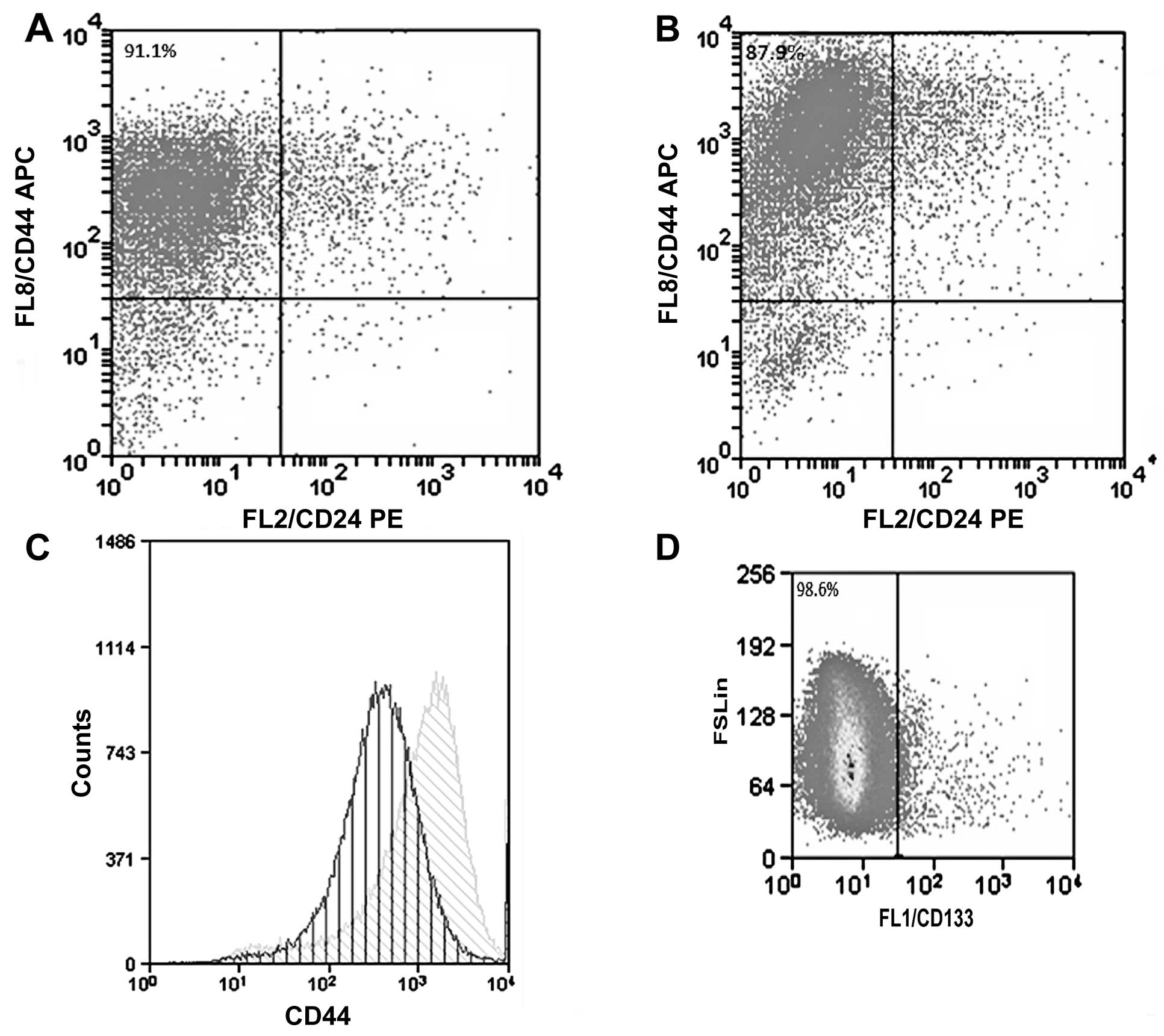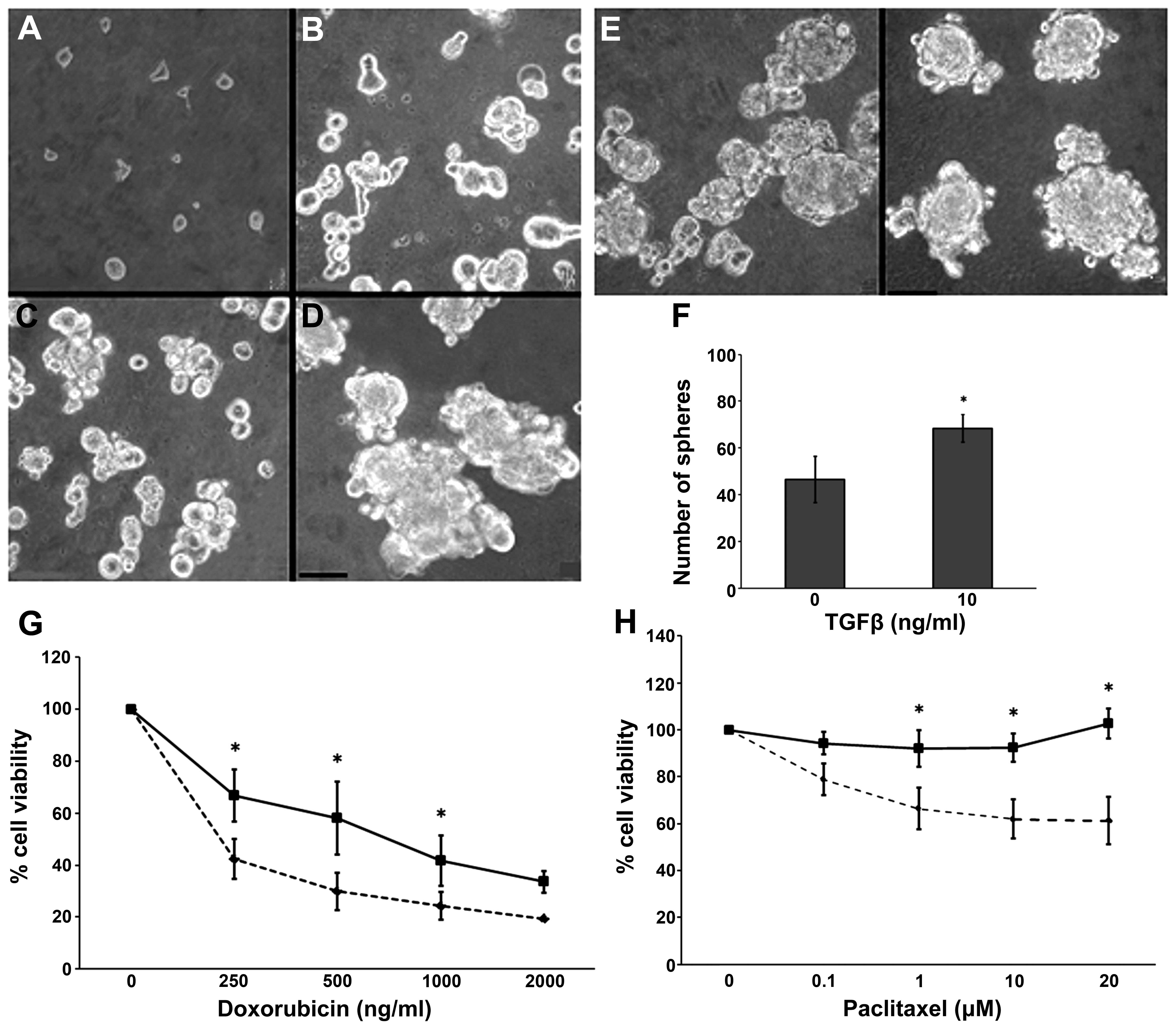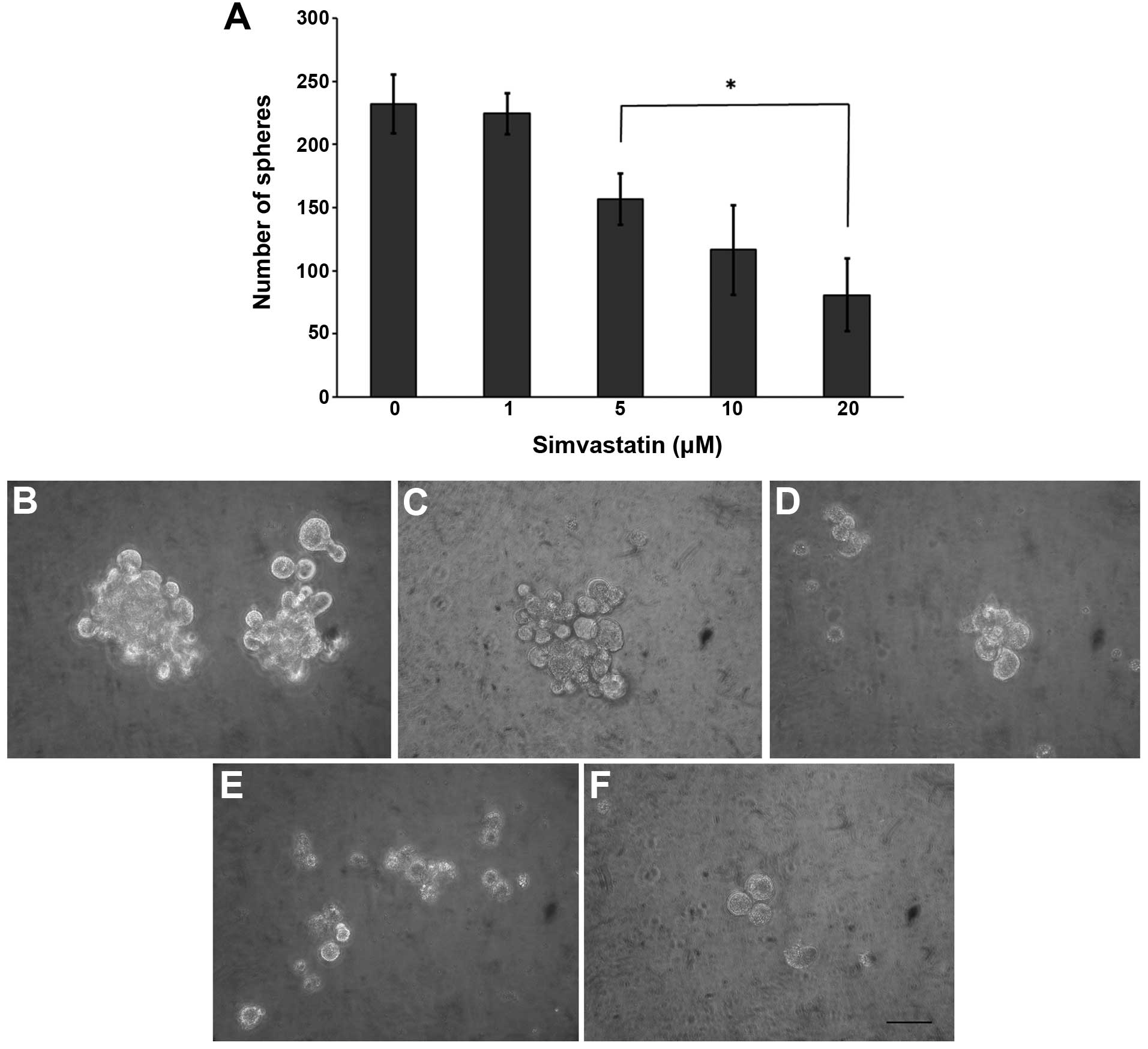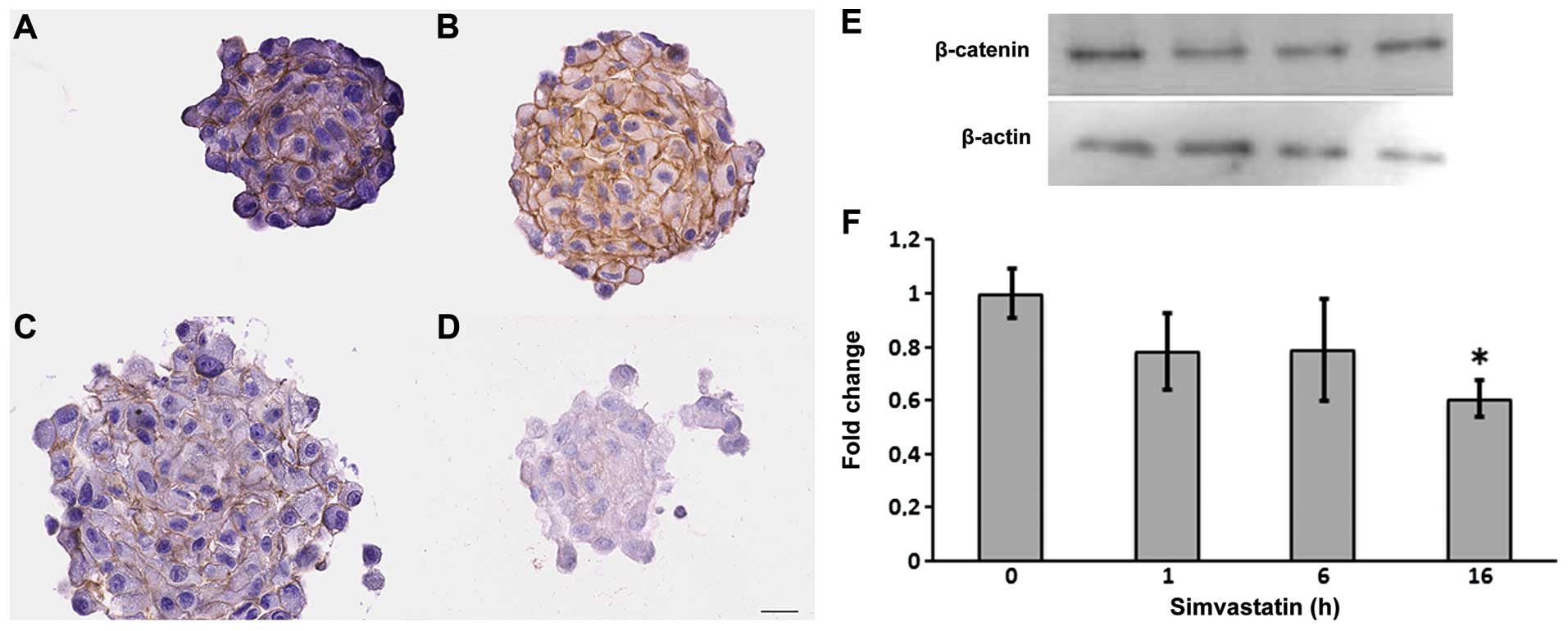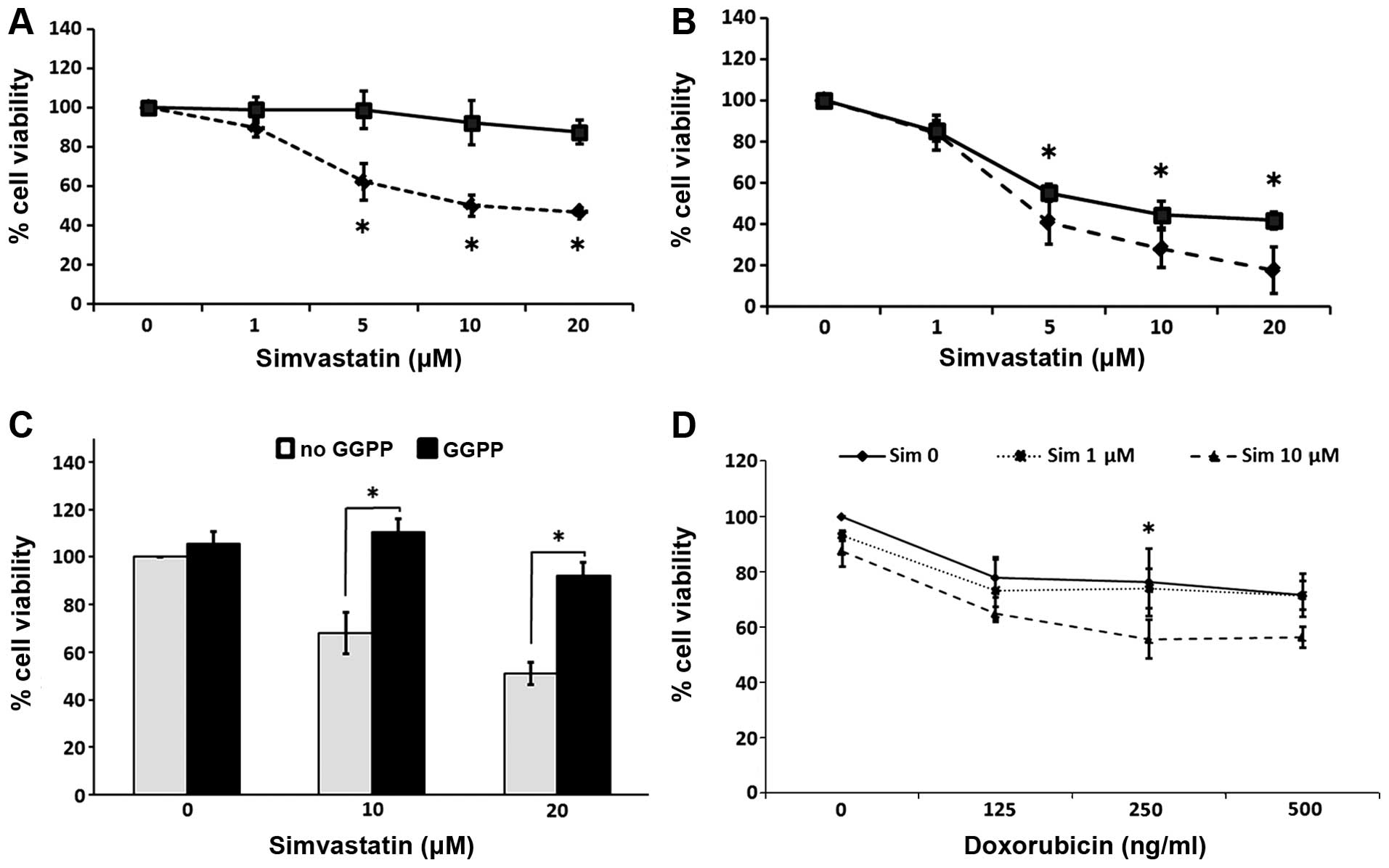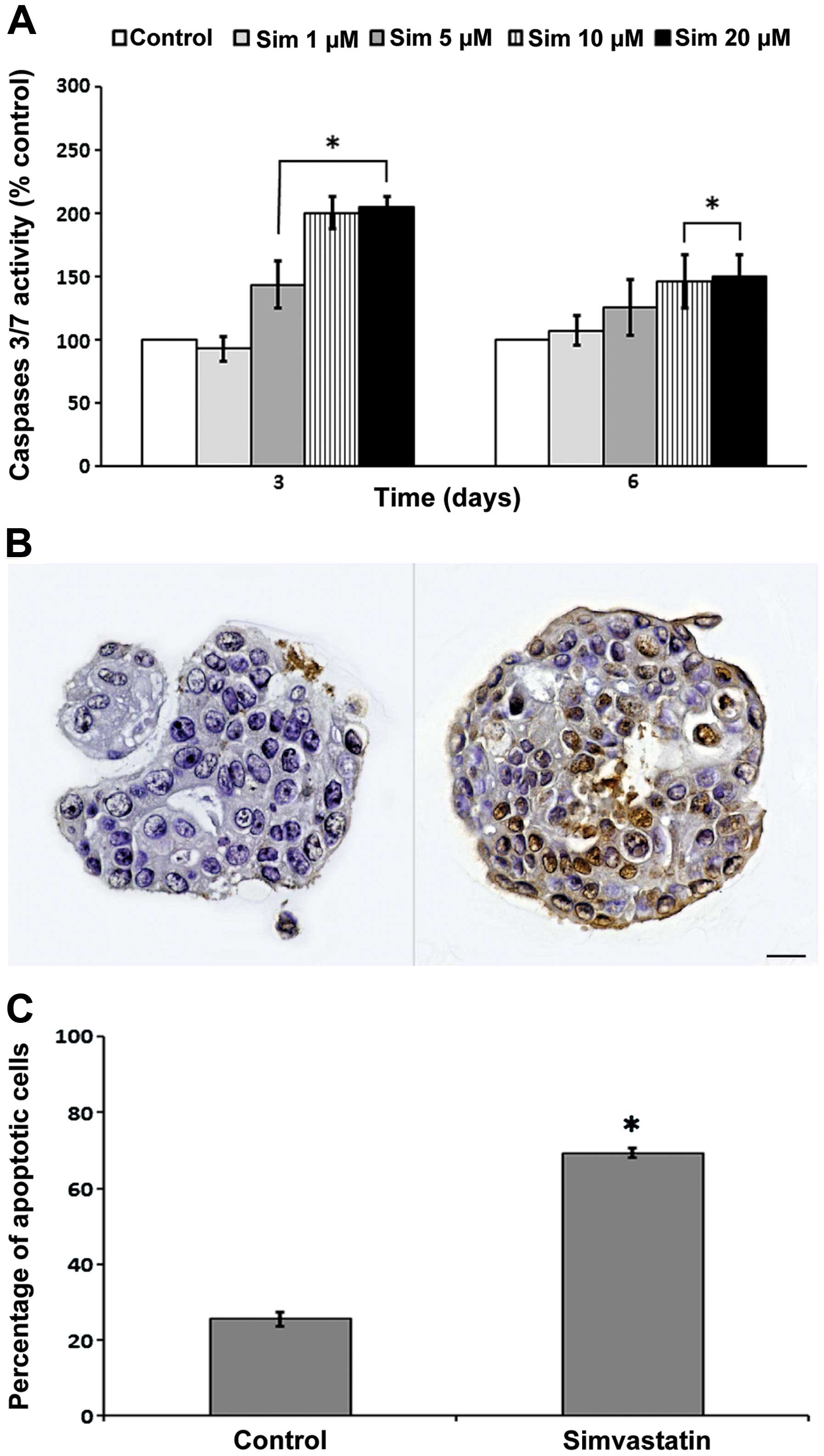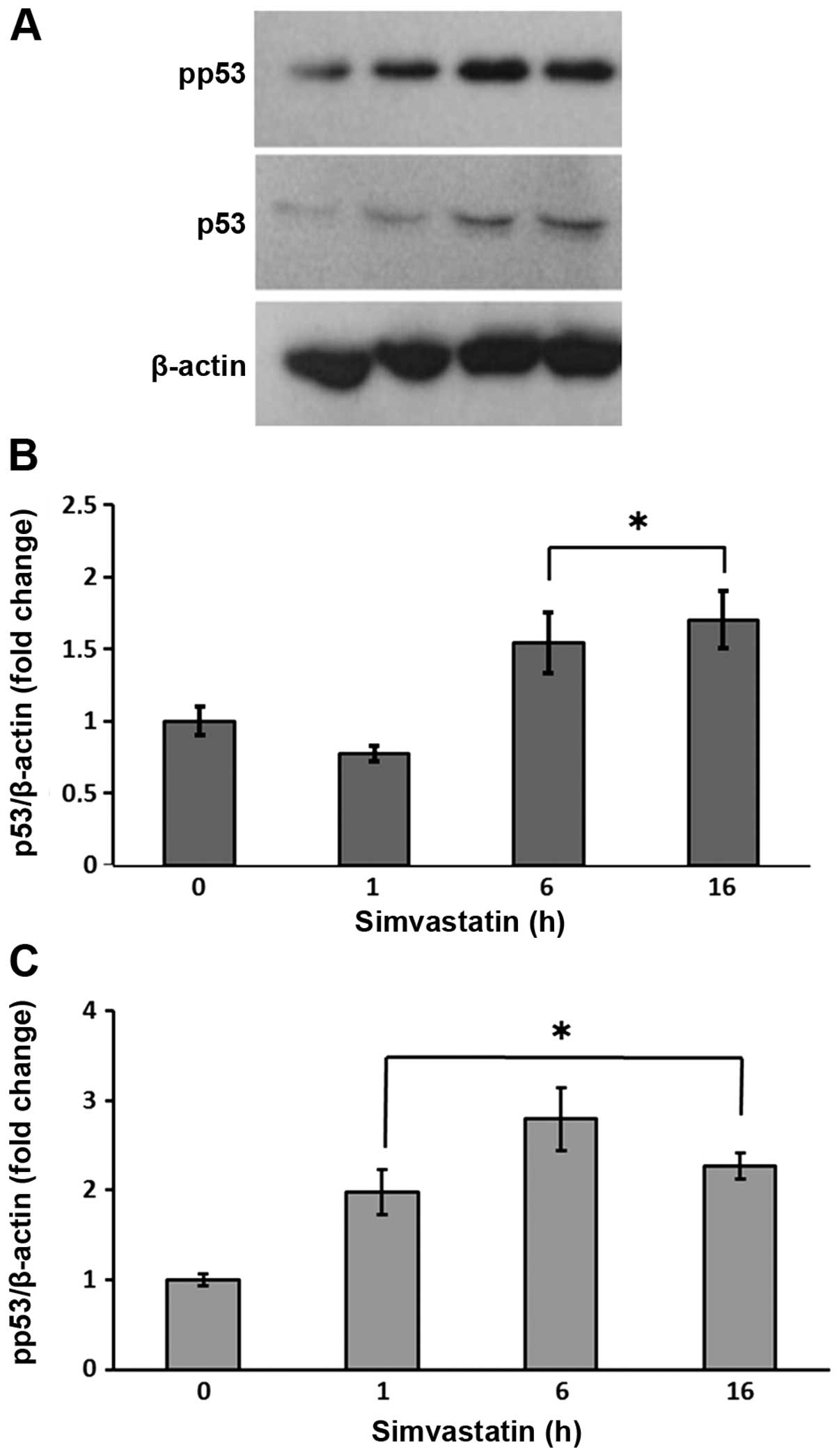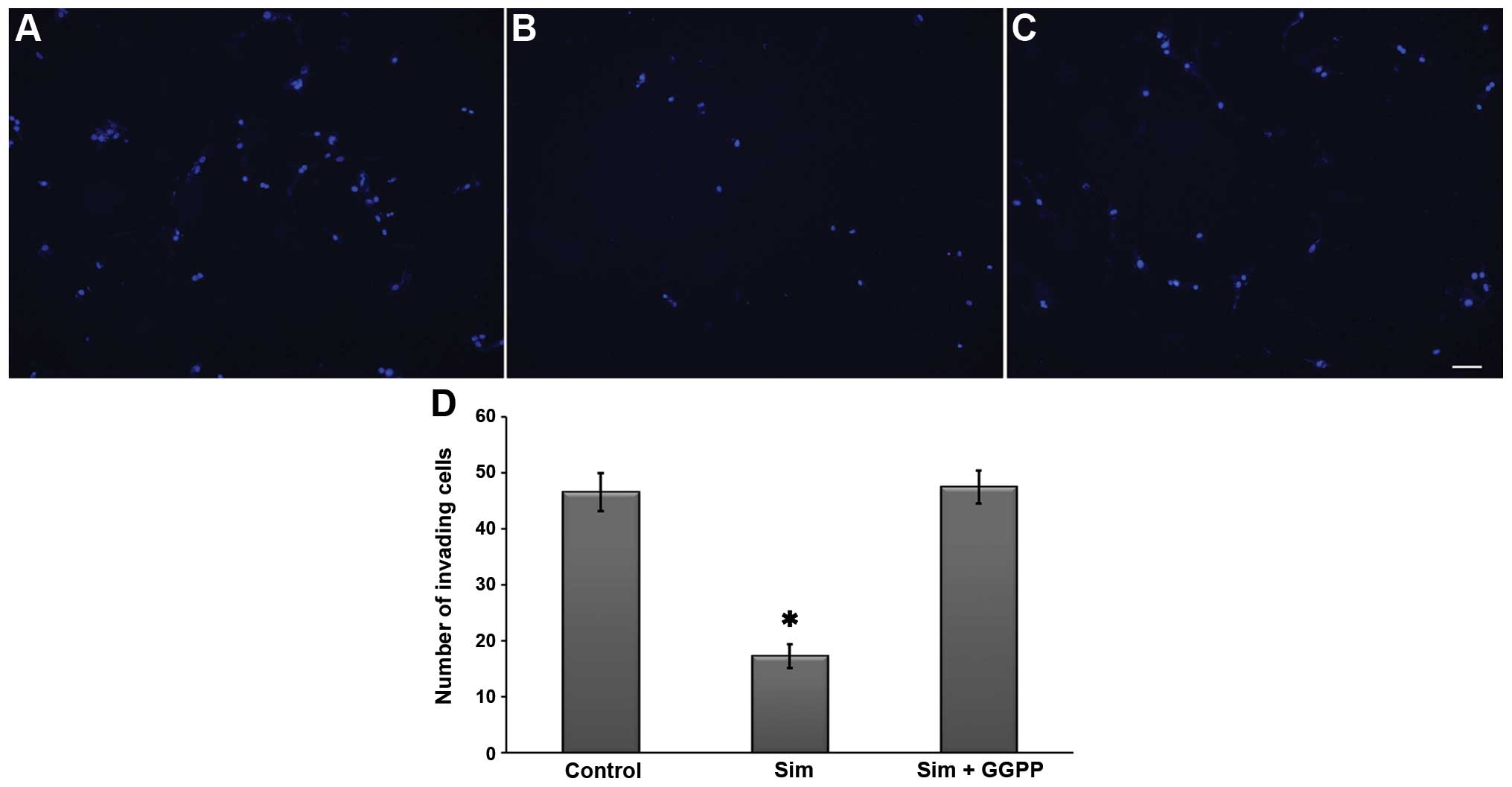Simvastatin exhibits antiproliferative effects on spheres derived from canine mammary carcinoma cells
- Authors:
- Published online on: March 13, 2015 https://doi.org/10.3892/or.2015.3850
- Pages: 2235-2244
Abstract
Introduction
Mammary cancer accounts for ~30% of all cancers observed in female dogs, displaying pathological and clinical heterogeneity (1) and exhibiting several similarities with breast cancer in humans (2,3). Approximately 50% of the tumors are malignant (4–6). To date, surgery is the treatment of choice for this disease; however, this therapeutic option is not feasible in the case of unresectable or extensive metastatic tumors (4,5). Currently, there is no effective therapy since some tumor cells may acquire resistance to commonly available drugs (7). A possible explanation for this situation is the presence of cancer stem-like cells (CSCs) within the tumor mass; CSCs exhibit self-renewal, resistance to several antitumor treatments such as chemotherapy and radiotherapy and possess tumor-initiating capacity (7,8). Several signaling pathways have been identified as relevant for maintaining the capacity of self-renewal and pluripotency of CSCs, including Wnt/β-catenin, hedgehog and Notch. The canonical Wnt/β-catenin pathway regulates several cell activities such as proliferation, migration and self-renewal, important features of CSCs (9). The chemoresistance appears to be related with the expression of ATP-binding transporters such as MDR, assuring efflux capability to CSCs (7,10). Mammary CSCs are characterized by a low expression of heat stable antigen CD24 and a high expression of hyaluronan receptor CD44 (7,9). The expression of other surface markers, such as CD133 and aldehyde dehydrogenase (ALDH), has been detected in these cells (9,11). Mammary CSCs exhibit the capacity to form spheres, structures that grow from disaggregated solid tumors cultured under harsh conditions in which only the more undifferentiated cells can survive and proliferate (7,8).
The statins are a group of commercially available therapeutic drugs used for the reduction in the circulating levels of cholesterol (12). These drugs exhibit additional effects, including an apparent prevention of the abnormal growth of tissues such as the prostate and mammary gland (12–15). In humans, several studies have suggested a link between statin use and a decrease in overall cancer incidence (15); however, other groups describe no association between the use of these drugs and a reduction in cancer risk (16). These controversial findings require further research to specify the role of statins in cancer. In veterinary medicine, no data on this topic have been published making the generation of information vital. Statins reduce serum cholesterol levels by competitively inhibiting 3-hydroxy-3-methylglutaryl coenzyme A reductase (HMG-CoAR) preventing the synthesis of cholesterol (13–15). The inhibition of HMG-CoAR causes a deficit in mevalonate, decreasing the formation of isoprenoid intermediates such as farnesyl pyrophosphate (Fpp) and geranylgeranyl pyrophosphate (GGPP); these participate in protein isoprenylation, a process that provides lipid attachment sites for some proteins, allowing them to participate in the regulation of cell survival and migration (17,18). In addition, it has been described that the effects of statins may occur via other mechanisms, such as reduction in the expression of CD44 via a transcriptional mechanism, non-related with HMG-CoAR (19). Thus, the precise mechanisms by which statins prevent mammary carcinogenesis are not completely understood; however, the participation of cell cycle-regulating proteins appears to be essential for this effect. Lipophilic statins such as simvastatin and lovastatin show antiproliferative, antimetastasic and pro-apoptotic effects in mammary tumor cells (20–22). These effects seem to be more powerful in estradiol receptor (ER)-negative breast cancer cells with permanently activated Ras or ErbB2 (mutated epidermal growth factor receptor) (23–25). Due to the high expression of CD44 in CSCs, we investigated the effect of statins on CSCs derived from canine mammary tumor cells. It should be mentioned that Gopalan et al recently demonstrated that simvastatin and γ-tocotrienol alone or in mixture decreased CSCs in drug-resistant human breast tumor cells (26); these observations appear to be related to the antiproliferative effect induced by simvastatin on karyotypically abnormal embryonic stem cells (27).
Based on the above-described data, it was imperative for us to explore new cytotoxic strategies to increase the efficacy of antitumor therapies on mammary CSCs, particularly in veterinary oncology. Therefore, in the present study, we characterized spheres derived from a canine mammary carcinoma cell line, analyzing the effects of simvastatin on sphere-forming capacity, cell viability, apoptosis and cell invasion. In addition, we explored various proteins (β-catenin and p53) associated with clonogenic ability and cell survival in response to simvastatin.
Materials and methods
Materials
Cell culture material was obtained from Nalge Nunc (Rochester, NY, USA). Ultra-low attachment plates were purchased from Corning (Corning, NY, USA). TGFβ, simvastatin, GGPP and paclitaxel were purchased from Sigma-Aldrich Inc. (St. Louis, MO, USA). Doxorubicin was purchased from Tocris Bioscience (Ellisville, MO, USA). CellTiter 96 Aqueous One Solution Cell Proliferation Assay and Apo-One Homogeneous Caspase-3/7 assay were purchased from Promega Corporation (Madison, WI, USA). ApopTag Peroxidase In Situ Apoptosis Detection kit was obtained from Millipore Co. (Billerica, MA, USA). BD BioCoat was obtained from BD Biosciences (Bedford, MA, USA). Most of the other biochemicals used were purchased from Sigma-Aldrich Inc. and Gibco by Life Technologies (Carlsbad, CA, USA).
Antibodies
APC rat anti-mouse CD44 clone IM7 (559250), PE rat anti-mouse CD24 clone M1/69 (553262) and mouse anti-β-catenin (610154) monoclonal antibodies were obtained from BD Pharmingen (San Jose, CA, USA). Anti-mouse CD133 monoclonal antibody clone 13A4 (14–1331) was obtained from eBioscience (San Diego, CA, USA). Polyclonal goat anti-p53 (sc-1311) and polyclonal rabbit anti-pp53 (sc-7997) antibodies were from Santa Cruz Biotechnology, Inc. (Santa Cruz, CA, USA). FITC-conjugated goat anti-rat IgG (pA1–28775) was purchased from Thermo Scientific (Rockford, IL, USA). Mouse monoclonal anti-β-actin antibody (ab8226) was from Abcam (Cambridge, UK). Peroxidase-conjugated rabbit anti-goat IgG (A5420), peroxidase-conjugated goat anti-rabbit IgG (A6667) and peroxidase-conjugated goat anti-mouse IgG (A9917) were purchased from Sigma-Aldrich Inc.
Cell line
CF41.Mg epithelial cells from canine mammary cancer tissue (CRL-6232; ATCC, Manassas, VA, USA), were cultured in Dulbecco’s modified Eagle’s medium (DMEM) high glucose containing 10% fetal bovine serum (FBS), 2 mM L-glutamine, 100 μg/ml penicillin, 100 μg/ml streptomycin and 0.25 μg/ml amphotericin B. In each of the experiments, the cells were cultured at 37°C in a humidified incubator, in a 5% CO2 atmosphere.
Sphere formation assay
These experiments were performed as describes by Cocola et al (8). in brief, cultured CF41.Mg cells were detached and re-suspended in ultra-low attachment plates with serum-free DMEM/F12 culture medium containing 10 ng/ml bFGF, 10 ng/ml EGF, 5 μg/ml insulin, 4 μg/ml heparin, B27 and 20 μg/ml penicillin, 20 μg/ml streptomycin and 0.05 μg/ml amphotericin B (sphere medium). To assess self-renewal capacity, cells derived from spheres were disaggregated and reseeded in 6-well ultra-low attachment plates. The spheres that formed were observed and photographed at low magnification every other day up to 7 days of culture. The effect of TGFβ (10 ng/ml) on the sphere formation efficiency was studied by counting at 7 days of culture at low magnification using an Olympus phase contrast microscope (CKX41 model; Tokyo, Japan).
Flow cytometric analysis
Cells derived from the spheres were dissociated with 0.25% trypsin-EDTA, washed and resuspended with phosphate-buffered saline (PBS) plus 2% FBS, and then incubated with specific labelled antibodies against CD44, CD24 and CD133 at 4°C for 45 min, as described by Michishita et al (7). For CD133 detection, secondary FITC-conjugated goat anti-rat antibody was used. The cell populations were analyzed within 30 min by flow cytometry using a BD FACSCalibur cytometer (BD Biosciences, San Jose, CA, USA).
Cell viability studies
CF41.Mg cells (~5,000/cm2) were seeded in ultra-low attachment plates and incubated for 24 h; then, the cells were incubated with several concentrations of doxorubicin and paclitaxel. After that, incubations with different concentrations of simvastatin (0–20 μM), in the absence or presence of 30 μM GGPP and doxorubicin were performed. In parallel, similar experiments on parental cells (grown in DMEM-high glucose plus 10% FBS) were run. At the completion of the incubation period, cell viability was estimated using a 3-(4,5-dimethylthiazol-2-yl)-5-(3-carbo-xymethoxyphenyl)-2-(4-sulfophenyl)-2H-tetrazolium (MTS) assay (CellTiter 96 Aqueous One Solution); MTS is reduced to formazan by viable cells. The quantity of formazan was measured by absorbance on a BioTek Synergy MX microplate reader at 490 nm (Winooski, VT, USA). In addition, the effects of simvastatin on sphere formation efficiency were conducted. Each experiment was performed at least 3 times in triplicate.
Caspase activity
Apoptosis was analyzed by measuring the activity of caspase-3/7 (Apo-One Homogeneous Caspase-3/7 assay), following the manufacturer’s instructions. Briefly, 5,000 cells/cm2 were seeded in the sphere medium without or with different concentrations of simvastatin, for 3–6 days. Caspase-3/7 activity was measured with a BioTek Synergy Mx microplate reader at an excitation wavelength of 485 nm and emission wavelength of 520 nm (Winooski, VT, USA). Caspase-3/7 activity was expressed relative to the number of total living cells.
TUNEL assay
The in situ staining of DNA strand breaks, a typical characteristic of end apoptotic cells was detected by the TUNEL (ApopTag Peroxidase In Situ Apoptosis Detection kit) assay according to the manufacturer’s instructions. Cells derived from the spheres were exposed to 10 μM simvastatin for 3 and 6 days, fixed in alcoholic glyoxal for 6 h and sedimented in warmed 1% agarose. After solidification, the cell blocks were dehydrated, embedded in paraffin, cut (4 μm) and rehydrated. The sections were digested with proteinase K and endogenous peroxidase quenched. After several washes, the slides were incubated with TdT enzyme for 60 min in a humidified chamber at 37°C. The samples were then washed and incubated with anti-digoxigenin conjugate for 30 min at room temperature. After extensive washes, the samples were developed with 3,3′-diaminobenzidine, counterstained with Mayer’s hematoxylin, dehydrated and mounted with Eukitt (Foster City, CA, USA). Finally, the samples were inspected with an Olympus light microscope (FSX100 model) fitted with a color CCD camera. In each experiment, the images were captured under fixed settings of illumination, exposure times and camera gain.
Immunocytochemistry assays
Spheres were exposed to 10 μM simvastatin for 1, 6 and 16 h, fixed in alcoholic glyoxal for 6 h and sedimented in warmed 1% agarose. After that, the cell blocks were dehydrated, embedded in paraffin, cut and rehydrated. The sections were subjected to heat antigen retrieval in a microwave with 0.01 M citrate buffer (pH 6.0) for 20 min. After cooling at room temperature for 20 min, blocking of endogenous peroxidase was performed with 10% H202. After several washes, the slides were blocked with 5% bovine serum albumin for 30 min in a humidified chamber at room temperature. The samples were then washed and incubated with the anti-β-catenin antibody diluted 1:100 at 4°C overnight. Then, the sections were incubated with Vector Universal reagent anti-mouse/rabbit IgG (Vector Laboratories, Inc., Burlingame, CA, USA) for 30 min at room temperature, following the manufacturer’s instructions. After 3 washes, the samples were developed with vector 3,3′-diaminobenzidine, counterstained with Mayer’s hematoxylin, dehydrated and mounted with Eukitt. Finally, the samples were inspected with an Olympus light microscope (FSX100 model) fitted with a color CCD camera. In each experiment, the images were obtained under fixed settings of illumination, exposure times and camera gain.
Invasion assays
These were carried out using BD BioCoat™ Matrigel™ invasion chambers (Transwell® 8-μm pore size, 24-wells; BD Biosciences, Bedford, MA, USA). Cells in the sphere medium containing 5 μM simvastatin and/or GGPP were incubated for 48 h against a gradient of 5% FBS. Non-invading cells were wiped from the upper side of the filter, and the nuclei of the invading cells were stained with DAPI. After fixation with cold methanol, the nuclei were inspected by epifluorescence (Olympus FSX100). For each condition, 3 Transwell units were used in the experiments; 5 microscopic fields were counted/insert.
Western blot analyses
For total cell protein extraction, statin-exposed and control cells were washed and harvested by scraping with RIPA lysis buffer containing 20 mM Tris-HCl pH 7.5, 150 mM NaCl, 1 mM Na2EDTA, 1 mM EGTA, 1% NP-40, 1% sodium deoxycholate, 2.5 mM sodium pyrophosphate, 1 mM β-glycerophosphate, 1 mM Na3VO4, 1 μg/ml leupetin and protease inhibitors. Cellular lysates were centrifugated and the protein content was determined by the Micro BCA™ assay (thermo Scientific, Rockford, IL, USA). For electrophoresis, 40 μg protein samples was boiled for 5 min and loaded on 10–15% polyacrylamide gels. Electrophoresis was run using Bio-Rad’s Mini-PROTEAN chambers. Bands were electro-transferred onto pVDF membranes. Immunodetection using appropriate primary antibodies and peroxidase labelled secondary antibodies, and development with enhanced chemiluminescence were carried out. Relative levels of total protein in each sample were determined by stripping the phospho-specific antibodies from the membrane and re-probing with antibodies against the non-phosphorylated proteins. The bands were analyzed with NIH’s ImageJ software.
Statistical analyses
Student’s t-test and ANOVA followed by post hoc comparisons of means were used to evaluate differences between samples and the respective controls. p<0.05 was considered to indicate a statistically significant result. Data were analyzed with InfoStat for Windows Software, AR.
Results
The culture of the CF41.Mg (parental) cells under anchorage-independent conditions and the absence of FBS allowed the isolation of spheres. These cell formations showed some characteristics of stemness, such as the preference for expression of the CD44+/CD24−/low phenotype; the cells, however, did not displayed CD133, a surface molecule frequently present in CSCs. The majority of parental CF41.Mg cells expressed high levels of CD44+/CD24−/low phenotype (91.1%), nevertheless spheres expressed a higher amount of CD44 (Fig. 1).
Cells derived from the spheres were disaggregated and seeded; they showed self-renewal capacity, a classical property of CSCs (Fig. 2A–D). Epithelial-mesenchymal transition (EMT) is a process that can be elicited by TGFβ and increases the proportion of CSCs in certain tumors. We assessed this effect on the spheres by adding 10 ng/ml TGFβ to the culture medium. We obtained an increased number of spheres without any effect on their size (Fig. 2E and F). As compared to the parental CF41.Mg cells, the sphere-derived cells presented a relative drug resistance to doxorubicin and paclitaxel. The results from the resistance analyses are summarized in Fig. 2G and H.
Since simvastatin impairs tumor cells with high CD44 expression, we analyzed its potential antiproliferative effect on CSCs. The statin significantly decreased the sphere forming efficiency in a concentration-dependent manner (Fig. 3), reducing both the number and size. In response to simvastatin, we observed a reduction in β-catenin expression. It has been speculated that this protein complex is involved in the self-renewal ability of CSCs (Fig. 4).
Simvastatin decreased the cell viability in a concentration-and exposure time-dependent manner, reaching a maximum effect at 20 μM and after 6 days of contact with the drug. The spheres exhibited a relative resistance to simvastatin in comparison with the parental cells, which showed a high sensitivity to the statin. Representative graphs of these experiments are presented in Fig. 5A and B. The simultaneous addition of 30 μM GGPP efficiently blocked the effects of simvastatin on the spheres (Fig. 5C). To determine whether simvastatin exerts a synergistic effect with doxorubicin, we assessed the cell viability in spheres grown in the presence of both drugs. By adding 10 μM of simvastatin, the antiproliferative effect induced by doxorubicin was enhanced. This cytotoxicity was compared to the effects of statin alone at 6 days of culture (Fig. 5D).
Exposure to simvastatin for 72 and 144 h significantly induced the activity of caspase-3/7 in relation to the control (Fig. 6A). This increased activity was directly proportional to the concentration. In spite of no evident changes in the proportion of living cells in response to simvastatin during 3 days of exposure, an increase in caspase-3/7 activity was observed, suggesting the activation of apoptotic processes. Therefore, we evaluated apoptosis through the TUNEL method, based on the detection of DNA strand breaks characteristic of DNA fragmentation. For this purpose, spheres grown in presence of 10 μM simvastatin were included in cell blocks, and then cut and stained. The spheres exposed to simvastatin for 6 days exhibited a 45.8% increase in apoptotic cell death compared to the control condition in replicated experiments; the differences was statistically significant (Fig. 6B and C).
As shown in Fig. 7, a progressive increase in both p53 expression and its phosphorylation was detected in the spheres exposed to simvastatin for 16 h. This was consistent with the antiproliferative and apoptotic effects of the statin.
Since spheres have invasive potential, we performed Transwell invasion assays with 5 μM simvastatin in the presence or absence of GGPP. As shown in Fig. 8, the results indicated the inhibition of invasiveness in the presence of the statin. The effect was hindered by 30 μM GGPP, suggesting that the anti-invasive effect of simvastatin is dependent on the inhibition of protein prenylation as observed in the cell viability analysis.
Discussion
Similar to the mammary gland, solid tumors are heterogeneous, presenting different cell populations with varying rates of proliferation and differentiation, In addition, tumors exhibit variable metastatic capacity and response to treatments (28,29). According to the cancer stem cell model, also known as the ʻtumor initiating cell modelʼ, a small subpopulation of tumorigenic cells located within the tumor exhibit capacities associated with stemness, that is, exhibit the ability for continuous self-renewal, differentiation, initiation and perpetuation of a tumor (30–32). To date, several groups have reported in vitro and in vivo data supporting the concept that CSCs are associated with malignancy (33,34). Yang et al found a high proportion of cancer stem-like cells in breast cancer tissues of poor prognosis (basal-like type and triple-negative form), suggesting that CSCs have prognostic value in this type of tumor (35). In canine mammary cancer, preliminary studies have shown that the presence of the CD44+/CD24− phenotype is directly related to high histological grade carcinomas (36).
The tumor microenvironment is significant for CSC development since it regulates the stemness level (31), explaining in part the plasticity shown by these cells. In our experiments, spheres derived from CF41.Mg cells exhibited different features consistent with stemness (anchorage-independent growth, high expression of CD44, auto-renewal and chemoresistance). However, the cells did not express CD133, a biomarker usually present in CSCs. In veterinary literature, there are discordant data concerning the expression of CD133 in canine mammary CSCs derived from different cell lines (7,11), supporting the view of a high phenotypic variability for CSCs. Among others, the tumor microenvironment is the product of various cell types present, which promote a distinct pro-inflammatory and pro-tumorigenic niche. There is evidence that macrophages and adipocytes participate in this process, releasing molecules involved in CSC development, such as TNFα and TGFβ that modulate the Wnt/β-catenin pathway and EMT, respectively (37). In this context, we analyzed the effect of TGFα on the clonogenic capacity of spheres. The number of spheres was significantly increased by the treatment confirming that this growth factor is important to induce CSCs, as previously proposed (10).
In both canine and human mammary cancers, some CSCs become resistant to conventional antitumor treatments, including chemotherapy with doxorubicin, weakening the treatment of many mammary tumors (7,26,38). Concordant with the above, we observed that spheres showed chemoresistance to doxorubicin and paclitaxel in relation to the parental cells. In the presence of the highest concentrations of paclitaxel, the spheres tended to disaggregate, yet this did not mean greater cytotoxicity, suggesting this drug may impair sphere-forming capacity without changing their viability (data not shown).
The present study is the first report showing the antitumor properties of simvastatin on canine mammary carcinoma cell-derived CSCs. The statin impaired both the sphere-forming ability and cell viability, generating a maximum effect at 20 μM. The spheres exhibited resistance to simvastatin at 3 days of exposure, with almost no cytotoxicity as compared to the parental cells.
The canonical Wnt/β-catenin signaling pathway regulates critical processes related to cancer cells such as proliferation, migration and differentiation, among others (39). The self-renewal of cancer stem cells is also modulated by this pathway (40). Thus, the development of drugs that inhibit this signaling route is desirable. β-catenin is a protein that acts as a transcriptional co-regulator, and in conjunction with E-cadherin, is also involved in cell-to-cell adhesion (41). In the present study, β-catenin was expressed in the plasma membrane of cell spheres and the expression was reduced by simvastatin. These observations suggest that simvastatin partially impairs sphere-forming ability and cell viability through this pathway. Wang et al recently reported that β-catenin signaling is associated with drug resistance to upregulate ATP binding cassette subfamily G2 (ABCG2) proteins in high malignant breast cancer (42,43). On the other hand, activation of Akt and Wnt/β-catenin signaling confers chemoresistance to CSCs inducing a more efficient DNA repair mechanism (44). As shown in Fig. 5D, the addition of 10 μM of simvastatin exerted a synergistic effect with doxorubicin on spheres at 3 days of exposure, a time point at which they slightly respond to statin. The above described drug resistance mechanisms mediated by β-catenin may be inhibited by the statin through an unclear mechanism, which warrants further investigation explore in future studies.
According to of our results, simvastatin activate apoptosis, a process evaluated through caspase-3/7 activity and DNA fragmentation assays Despite the fact that simvastatin did not generate changes in cell viability at 3 days of incubation, the statin induced the activity of caspase-3/7 as a pro-apoptotic event. After 6 days of exposure to simvastatin, caspase activity remained and DNA fragmentation was increased, indicating a late apoptotic event. In this context, these changes have been associated with an increase in the expression of cell cycle-negative regulatory proteins such as p53 (19) and p21 (45). We observed a higher expression and phosphorylation of p53 in response to simvastatin, confirming the results described in the literature (45,46). Apoptosis generated by simvastatin is probably related to the induction of intracellular radical oxygen species (45); the oxidative stress leads to an increase in p53 by inducing cell arrest and apoptosis (19). Thus, treatment with statin leads to an increase in pro-apoptotic Bax protein and activation of caspase-9 and -3 (46). In addition to the antiproliferative effects produced by simvastatin, this drug impaired invasiveness of spheres derived from CF41.Mg cells, promoting an antimetastatic potential effect. Mandal et al demonstrated that simvastatin decreased the invasive and metastatic potential of MDA-MB-231 CD44-positive cells (19), which is consistent with our observations.
Since the main mechanism of action of simvastatin is the disruption of this pathway through inhibition of HMGCoAR (14), we evaluated whether some of the effects of the drug were mediated by post-translational modifications associated with the inhibition of the mevalonate pathway. For this purpose, we conducted experiments adding the isoprenoid GGPP to the culture medium (14). The inhibitory effect induced by the statin on the cell viability and invasiveness was completely reverted, suggesting that these properties are dependent on protein isoprenylation. Several studies have shown that the effects of simvastatin and other statins are reversed in the presence of GGPP or mevalonate, but not by cholesterol or farnesyl pyrophosphate (46). This means that GGPP synthesis is relevant for the modulation of the activity of proteins involved in cell migration and survival, through an association with the plasma membrane. Our results suggest that simvastatin plays a role in the proliferative behavior of cancer stem-like cells. Therefore, statins represent valuable potential agents against CSCs by enhancing the effects of conventional chemotherapy in canines with mammary tumors.
Acknowledgments
The present study was supported by the Fondecyt Chile, grant 11110148. We wish to thank Dr Walter D. Sierralta and Dr Jose I. Arias for their technical assistance.
References
|
Torres CG, Pino AM and Sierralta WD: A cyclized peptide derived from α-fetoprotein inhibits the proliferation of ER-positive canine mammary cancer cells. Oncol Rep. 21:1397–1404. 2009.PubMed/NCBI | |
|
Paoloni M and Khanna C: Translation of new cancer treatment from pets dogs to humans. Nat Rev Cancer. 8:147–156. 2008. View Article : Google Scholar : PubMed/NCBI | |
|
Khanna C, Lindblad-Toh K, Vail D, London C, Bergman P, Barber L, Breen M, Kitchell B, Mcneil E, Modiano JF, Niemi S, Comstock KE, Ostrander E, Westmoreland S and Withrow S: The dog as a cancer model. Nat Biotechnol. 24:1065–1066. 2006. View Article : Google Scholar : PubMed/NCBI | |
|
Sorenmo KU, Rasotto R, Zappulli V and Goldschmidt MH: Development, anatomy, histology, lymphatic drainage, clinical features, and cell differentiation markers of canine mammary gland neoplasms. Vet Pathol. 48:85–97. 2011. View Article : Google Scholar | |
|
Klopfleisch R, von Euler H, Sarli G, Pinho SS, Gärtner F and Gruber AD: Molecular carcinogenesis of canine mammary tumors: news from an old disease. Vet Pathol. 48:98–116. 2011. View Article : Google Scholar | |
|
Rivera P and von Euler H: Molecular biological aspects on canine and human mammary tumors. Vet Pathol. 48:132–146. 2011. View Article : Google Scholar | |
|
Michishita M, Akiyoshi R, Yoshimura H, Katsumoto T, Ichikawa H, Ohkusu-Tsukada K, Nakagawa T, Sasaki N and Takahashi K: Characterization of spheres derived from canine mammary gland adenocarcinoma cell lines. Res Vet Sci. 91:254–260. 2011. View Article : Google Scholar | |
|
Cocola C, Anastasi P, Astigiano S, Piscitelli E, Pelucchi P, Vilardo L, Bertoli G, Beccaglia M, Veronesi MC, Sanzone S, Barbieri O, Reinbold RA, Luvoni GC and Zucchi I: Isolation of canine mammary cells with stem cell properties and tumour-initiating potential. Reprod Domest Anim. 44(Suppl 2): S214–S217. 2009. View Article : Google Scholar | |
|
Pang LY and Argyle D: Cancer stem cells and telomerase as potential biomarkers in veterinary oncology. Vet J. 185:15–22. 2010. View Article : Google Scholar : PubMed/NCBI | |
|
Pang LY, Cervantes-Arias A, Else RW and Argyle DJ: Canine mammary cancer stem cells are radio- and chemo-resistant and exhibit an epithelial-mesenchymal transition phenotype. Cancers. 3:1744–1762. 2011. View Article : Google Scholar | |
|
Blacking TM, Waterfall M, Samuel K and Argyle DJ: Flow cytometric techniques for detection of candidate cancer stem cell subpopulations in canine tumour models. Vet Comp Oncol. 10:252–273. 2012. View Article : Google Scholar : PubMed/NCBI | |
|
Boudreau DM, Yu O and Johnson J: Statin use and cancer risk: a comprehensive review. Expert Opin Drug Saf. 9:603–621. 2010. View Article : Google Scholar : PubMed/NCBI | |
|
Behbod F and Rosen JM: Will cancer stem cells provide new therapeutic targets? Carcinogenesis. 26:703–711. 2005. View Article : Google Scholar | |
|
Demierre MF, Higgins PDR, Gruber SB, Hawk E and Lippman SM: Statins and cancer prevention. Nat Rev Cancer. 5:930–942. 2005. View Article : Google Scholar : PubMed/NCBI | |
|
Campbell MJ, Esserman LJ, Zhou Y, Shoemaker M, Lobo M, Borman E, Baehne F, Kumar AS, Adduci K, Marx C, Petricoin EF, Liotta LA, Winters M, Benz S and Benz CC: Breast cancer growth prevention by statins. Cancer Res. 66:8707–8714. 2006. View Article : Google Scholar : PubMed/NCBI | |
|
Taylor ML, Wells BJ and Smolak MJ: Statins and cancer: a meta-analysis of case-control studies. Eur J Cancer Prev. 17:259–268. 2008. View Article : Google Scholar : PubMed/NCBI | |
|
Mück AO, Seeger H and Wallwiener D: Inhibitory effect of statins on the proliferation of human breast cancer cells. Int J Clin Pharmacol Ther. 42:695–700. 2004. View Article : Google Scholar : PubMed/NCBI | |
|
Kusama T, Mukai M, Tatsuta M, Nakamura H and Inoue M: Inhibition of transendothelial migration and invasion of human breast cancer cells by preventing geranylgeranylation of Rho. Int J Oncol. 29:217–223. 2006.PubMed/NCBI | |
|
Mandal CC and Ghosh-Choudhury N, Yoneda T, Choudhury GG and Ghosh-Choudhury N: Simvastatin prevents skeletal metastasis of breast cancer by an antagonistic interplay between p53 and CD44. J Biol Chem. 286:11314–11327. 2011. View Article : Google Scholar : PubMed/NCBI | |
|
Borgquist S, Djerbi S, Pontén F, Anagtosnaki L, Goldman M, Gaber A, Manjer J, Landberg B and Jirström K: HMG-CoA reductase expression in breast cancer is associated with a less aggressive phenotype and influenced by anthropometric factors. Int J Cancer. 123:1146–1153. 2008. View Article : Google Scholar : PubMed/NCBI | |
|
Yu X, Luo Y, Zhou Y, Zhang Q, Wang J, Wei N, Mi M, Zhu J, Wang B, Chang H and Tang Y: BRCA1 overexpression sensitizes cancer cells to lovastatin via regulation of cyclin D1-CDK4-p21WAF1/Cip1 pathway: Analyses using a breast cancer cell line and tumoral xenograft model. Int J Oncol. 33:555–563. 2008.PubMed/NCBI | |
|
Kato S, Smalley S, Sadarangani A, Chen-Lin K, Oliva B, Brañes J, Carvajal J, Gejman R, Owen GI and Cuello M: Lipophilic but not hydrophilic statins selectively induce cell death in gynecological cancers expressing high levels of HMGCoA reductase. J Cell Mol Med. 14:1180–1193. 2010. | |
|
Kumar AS, Benz CC, Shim V, Minami CA, Moore DA and Esserman LJ: Estrogen receptor-negative breast cancer is less likely to arise among lipophilic statin users. Cancer Epidemiol Biomarkers Prev. 17:1028–1033. 2008. View Article : Google Scholar : PubMed/NCBI | |
|
Herrero-Martin G and López-Rivas A: Statins activate a mitochondria-operated pathway of apoptosis in breast tumor cells by a mechanism regulated by ErbB2 and dependent on the prenylation of proteins. FEBS Lett. 582:2589–2594. 2008. View Article : Google Scholar : PubMed/NCBI | |
|
Kang S, Kim ES and Moon A: Simvastatin and lovastatin inhibit breast cell invasion induced by H-Ras. Oncol Rep. 21:1317–1322. 2009.PubMed/NCBI | |
|
Gopalan A, Yu W, Sanders BG and Kline K: Eliminating drug resistant breast cancer stem-like cells with combination of simvastatin and γ-tocotrienol. Cancer Lett. 328:285–296. 2013. View Article : Google Scholar | |
|
Gauthaman K, Manasi N and Bongso A: Statins inhibit the growth of variant human embryonic stem cells and cancer cells in vitro but not normal human embryonic stem cells. Br J Pharmacol. 157:962–973. 2009. View Article : Google Scholar : PubMed/NCBI | |
|
Geng SQ, Alexandrou AT and Li JJ: Breast cancer stem cells: multiple capacities in tumor metastasis. Cancer Lett. 349:1–7. 2014. View Article : Google Scholar : PubMed/NCBI | |
|
Lorico A and Rappa G: Phenotypic heterogeneity of breast cancer stem cells. J Oncol. 2011:1350392011. View Article : Google Scholar : PubMed/NCBI | |
|
Al-Ejeh F, Smart CE, Morrison BJ, Chenevix-trench G, Lopez JA, Lakhani SR, Brown MP and Khanna KK: Breast cancer stem cells: treatment resistance and therapeutic opportunities. Carcinogenesis. 32:650–658. 2011. View Article : Google Scholar : PubMed/NCBI | |
|
Cruz MH, Sidén A, Calaf GM, Delwar ZM and Yakisich JS: The stemness phenotype model. ISRN Oncol. 2012:3926472012.PubMed/NCBI | |
|
Tang DG: Understanding cancer stem cell heterogeneity and plasticity. Cell Res. 22:457–472. 2012. View Article : Google Scholar : PubMed/NCBI | |
|
Zhou BB, Zhang H, Damelin M, Geles KG, Grindley JC and Dirks PB: Tumour-initiating cells: challenges and opportunities for anticancer drug discovery. Nat Rev Drug Discov. 8:806–823. 2009. View Article : Google Scholar : PubMed/NCBI | |
|
Geng SQ, Alexandrou AT and Li JJ: Breast cancer stem cells: multiple capacities in tumor metastasis. Cancer Lett. 349:1–7. 2014. View Article : Google Scholar : PubMed/NCBI | |
|
Yang G, Xue F and Chen X: prognostic value of different amounts of cancer stem cells in different molecular subtypes of breast cancer. Gland Surg. 1:20–24. 2012.PubMed/NCBI | |
|
Magalhães GM, Terra EM, de Oliveira Vasconcelos R, de Barros Bandarra M, Moreira PR, Rosolem MC and Alessi AC: Immunodetection of cells with a CD44+/CD24− phenotype in canine mammary neoplasms. BMC Vet Res. 9:2052013. View Article : Google Scholar | |
|
Pérez-Hernández AI, Catalán V, Gómez-Ambrosi J, Rodríguez A and Frühbeck G: Mechanisms linking excess adiposity and carcinogenesis promotion. Front Endocrinol. 5:652014. | |
|
Tanabe A, Deguchi T, Sato T, Nemoto Y, Maruo T, Madarame H, Shida T, Naya Y, Ogihara K and Sahara H: Radioresistance of cancer stem-like cell derived from canine tumours. Vet Comp Oncol. Jul 28–2014.Epub ahead of print. View Article : Google Scholar : PubMed/NCBI | |
|
Li J and Zhou BP: Activation of β-catenin and Akt pathways by Twist are critical for the maintenance of EMT associated cancer stem cell-like characters. BMC Cancer. 11:492011. View Article : Google Scholar | |
|
Roarty K and Rosen JM: Wnt and mammary stem cells: hormones cannot fly wingless. Curr opin pharmacol. 10:643–649. 2010. View Article : Google Scholar : PubMed/NCBI | |
|
Torres CG, Ramírez ME, Cruz P, Epuñan MJ, Valladares L and Sierralta WD: 27-Hydroxycholesterol induces the transition of MCF7 cells into a mesenchymal phenotype. Oncol Rep. 26:389–397. 2011.PubMed/NCBI | |
|
Wang N, Wang Z, Peng C, You J, Shen J, Han S and Chen J: Dietary compound isoliquiritigenin targets GRP78 to chemosensitize breast cancer stem cells via β-catenin/ABCG2 signaling. Carcinogenesis. 35:2544–2554. 2014. View Article : Google Scholar : PubMed/NCBI | |
|
Wang Z, Wang N, Li W, Liu P, Chen Q, Situ H, Zhong S, Guo L, Lin Y, Shen J and Chen J: Caveolin-1 mediates chemoresistance in breast cancer stem cells via β-catenin/ABCG2 signaling pathway. Carcinogenesis. 35:2346–2356. 2014. View Article : Google Scholar : PubMed/NCBI | |
|
Zafarana G and Bristow RG: Tumor senescence and radioresistant tumor-initiating cells (TICs): let sleeping dogs lie! Breast Cancer Res. 12:1112010. View Article : Google Scholar : PubMed/NCBI | |
|
Guterres FA, Martinez GR, Rocha ME and Winnischofer SM: Simvastatin rises reactive oxygen species levels and induces senescence in human melanoma cells by activation of p53/p21 pathway. Exp Cell Res. 319:2977–2988. 2013. View Article : Google Scholar : PubMed/NCBI | |
|
Wang Y, Xu SL, Wu YZ, Zao MS, Xu WJ, Yang HY and Li YX: Simvastatin induces caspase-dependent apoptosis and activates P53 in OCM-1 cells. Exp Eye Res. 113:128–134. 2013. View Article : Google Scholar : PubMed/NCBI | |
|
Zanfardino M, Spampanato C, De Cicco R, Buommino E, De Filippis A, Baiano S, Barra A and Morelli F: Simvastatin reduces melanoma progression in a murine model. Int J Oncol. 43:1763–1770. 2013.PubMed/NCBI |



